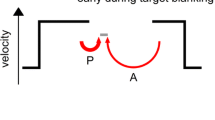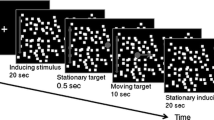Abstract
During natural behaviour in a visual environment, smooth pursuit eye movements (SP) usually override the vestibular-ocular reflex (VOR) and the optokinetic reflex (OKR), which stem from head-in-space and scene-relative-to-eye motion, respectively. We investigated the interaction of SP, VOR, and OKR, which is not fully understood to date. Eye movements were recorded in two macaque monkeys while applying various combinations of smooth eye pursuit, vestibular and optokinetic stimuli (sinusoidal horizontal rotations of visual target, chair and optokinetic pattern, respectively, at 0.025, 0.05, 0.1, 0.2, 0.4, and 0.8 Hz, corresponding to peak stimulus velocities of 1.25–40°/s for a standard stimulus of ±8°). Slow eye responses were analysed in terms of gain and phase. During SP at mid-frequencies, the eyes were almost perfectly on target (gain 0.98 at 0.1 Hz), independently of a concurrent vestibular or optokinetic stimulus. Pursuit gain at lower frequencies, although being almost ideal (0.98 at 0.025 Hz with pursuit-only stimulation), became modified by the optokinetic input (gain increase above unity when optokinetic stimulus had the same direction as target, decrease with opposite direction). At higher stimulus frequencies, pursuit gain decreased (down to 0.69 at 0.8 Hz), and the pursuit response became modified by vestibular input (gain increase during functionally synergistic combinations, decrease in antagonistic combinations).Thus, the pursuit system in monkey dominates during SP-OKR-VOR interaction, but it does so effectively only in the mid-frequency range. The results can be described in the form of a simple dynamic model in which it is assumed that the three systems interact by linear summation. In the model SP and OKR dominate VOR in the low- to mid-frequency/velocity range, because they represent closed loop systems with high internal gain values (>>1) at these frequencies/velocities, whereas the VOR represents an open loop system with about unity-gain (up to very high frequencies). SP dominance over OKR is obtained by allowing an ’attentional/volitional’ mechanism to boost SP gain and a predictive mechanism to improve its dynamics.
Similar content being viewed by others
Author information
Authors and Affiliations
Additional information
Received: 27 November 1998 / Accepted: 8 March 1999
Rights and permissions
About this article
Cite this article
Schweigart, G., Mergner, T. & Barnes, G. Eye movements during combined pursuit, optokinetic and vestibular stimulation in macaque monkey. Exp Brain Res 127, 54–66 (1999). https://doi.org/10.1007/s002210050773
Issue Date:
DOI: https://doi.org/10.1007/s002210050773




